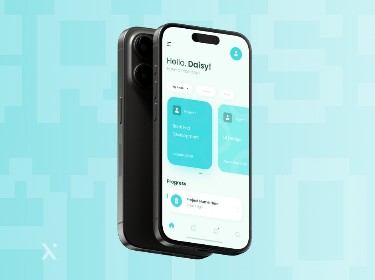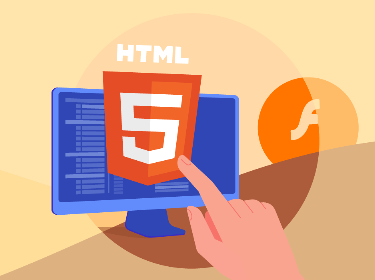Low-code and no-code platforms center around the idea of making the process of software development easier and more accessible. But which option is better and what criteria do you have to consider beforehand?
If you haven’t heard anything about low- and no-code app development platforms, it’s definitely time to catch up. The automation of software development has brought about numerous rapid application development (RAD) tools and platforms that have the capacity to completely upend the entire process, make it considerably faster, and, crucially, put some development-like capabilities into the hands of business users who have little or no at all technical background.
Both low-code and no-code development platforms offer an opportunity to develop software applications without having extensive knowledge of traditional programming languages. Instead, they rely on special visual integrated development environments (IDE) that empower users to design apps by simply dragging and dropping the necessary components. As a result, they significantly reduce development time and increase overall efficiency.
The concept of low-code/no-code development was introduced back in 2014, though its roots go back to the 1990s. These days, low- and no-code platforms are taking the software industry by storm, shortening the learning curve and reshaping traditional software development.
Sounds like fun, right? So, let’s continue exploring further to gain more insights about low-code and no-code development platforms, the differences between them, their benefits and limitations, and find out which option will fit your organization best.
Searching for new profitable business opportunities? Check out our Telegram Mini Apps Development services
Lowdown on low-code platforms
![]()
Low-code is a unique software development approach that allows you to deliver applications much faster and with minimal hand coding. A low-code app development platform is essentially a set of tools that allow for the visual development of applications via modeling and a graphical user interface.
With the minimum amount of hand coding, low-code permits users to quickly and seamlessly create solid apps with captivating UI, modern integrations, and understandable logic. Besides, it’s been estimated that the global low-code development market is expected to hit $187 billion by 2030.
Naturally, low-code development platforms are considered a good match for creating business process management apps that can be integrated with other apps, systems, and databases. Low-code enables non-professionals to join the development team and make their own contribution to the common project. Similarly, it enables even experienced developers to spend less time on app development than they would in a standard software project.
Using low-code builders gives organizations the chance to enhance their agility and streamline productivity. Low-code also offers end-to-end digitalization, which means that such a platform can be used throughout the entire application development cycle — from handling and organizing all business data and creating the app architecture to testing, development, and deployment management.
What can you build with low-code platforms?
Low-code development platforms are regarded as a perfect fit for building apps that deal with customer engagement, operational efficiency, and legacy migration.
Customer engagement apps
With the help of customer engagement applications, customers and partners can interact easily and efficiently with the organization. These apps are tremendously important for enhancing customer satisfaction and retention and generating bigger revenue. The most relevant examples of this kind of app are agent/broker and customer portals, claims management apps, special student service apps, self-service policy administration apps, and the like.
Considering that a lot of enterprises don’t have sufficient UX resources, low-code app development platforms have the advantage of offering an incorporated UI framework with numerous handy widgets and building blocks that aim to simplify the development of multi-channel apps for users without any UX background.
Operational efficiency apps
The main objective of operational efficiency apps (OEA) is to reduce costs by automating complicated and tiresome manual and/or paper-based processes. These apps are designed to support and optimize departmental, cross-departmental and organization-wide processes, and can be seamlessly integrated into the business’ core system. Some examples of operational efficiency applications are supply chain management, claims and invoice processing, university registration, and order management apps.
By applying well-designed and easy-to-use low-code platforms, organizations can facilitate the development of advanced operational efficiency applications and considerably simplify their processes.
Looking for an ideal document management system? Check out DocFlow
Legacy migration apps
Legacy migration applications are used to replace legacy applications that are unable to maintain new processes or offer the required user experience. Examples include legacy app migrations of Microsoft Access, Sharepoint, and Excel to updated systems.
When dealing with legacy migration, low-code can provide novel functionality and bring the overall UX to a whole new level. Low-code platforms also back up modern microservice architectures and make use of built-in capabilities that are good at tackling quality and maintainability issues at each development stage.
Getting to grips with no-code platforms
![]()
The introduction of no-code application development platforms marks a new era in the technological landscape. By using no-code builders, businesses, as well as individuals without coding skills, are capable of creating apps with the help of ready-made UI templates and a bunch of drag-and-drop features. No-code will exempt you from creating frameworks and connecting databases and will eliminate the need to deal with other laborious tasks that are inherent to hard coding. Thus, the app development process is tremendously simplified and users without a coding background (and even without a magic wand!) are able to develop apps themselves.
Who can make the most of no-code platforms?
No-code apps open up new horizons in terms of digital capabilities for a wide range of entities and individuals, including small businesses, sales and marketing teams, enterprises, consultants, and freelancers. They allow anyone to seize the chance to become a citizen developer and embark on developing business applications. Team members are also encouraged to design the applications that they themselves consider to be essential to fill gaps in numerous processes. No-code can be put to good use in a variety of business areas, including accounting and finance, HR and administration, marketing and sales.
Accounting and finance
Those who are engaged in the sphere of finance and accounting will find no-code applications extremely useful and convenient. The applications built on no-code platforms can be used in activities such as automatic reporting, profit and expense analysis, investment tracking, accounts receivable collection, payroll and invoice reporting — and that list is far from complete.
HR and administration
No-code provides an excellent opportunity to make HR automation more efficient and cheaper. The applications created on no-code platforms have a bunch of outstanding features such as relative ease-of-use and rapid deployment, and can significantly optimize employee onboarding along with performance reviews.
Marketing and sales
By using no-code applications, marketing teams can bolster their campaign creation and distribution. As a result, processes will run faster, more smoothly, and in a much more organized way. As well as this, no-code apps help process data for in-depth content, which can bring about even more valuable marketing and sales assets.
Understanding the difference between low-code and no-code
The line between low-code and no-code is not that sharp. The clue is in the names. Despite the fact that a low-code development platform involves only minimum coding requirements, it isn’t necessarily free from hard coding altogether. No-code development, though, can be mastered by anyone.
It’s also worth noting that though both options hinge on the idea of utilizing the benefits of visual modeling, there’s a significant difference in the scale and types of app that can be delivered via these approaches. So, no-code development tools can work well for businesses that are eager to solve simple functional use cases and design unsophisticated apps that will be used by a particular department within the organization. Moreover, apps that have been created on no-code platforms don’t have huge scalability or integration capabilities. In the long run, this can lead to issues with architectural considerations, extensibility, and governance.
On the other hand, low-code platforms are generally more scalable and flexible when it comes to cloud and/or on-premises deployment. They are also perfectly capable of extending their platform capabilities via open APIs intended for reusability. Compared to no-code, low-code platforms are suitable for creating more sophisticated apps and are able to address a larger number of use cases thanks to their general-purpose nature. What’s more, a number of low-code platforms can be integrated with third-party smart services such as AI, machine learning consulting services, IoT, voice and facial recognition services, and some other tools provided by the open source community.
Take a look at this mobile application that gives homeowners full control of their smart devices
Key features to consider when comparing the platforms
To make it easier to distinguish between low- and no-code platforms, let’s focus on the main criteria represented in the table below.
| Low-code | No-code | |
| Visual integrated development environment | + | + |
| Seamless integration with other services | + | – |
| Suitable for business applications | + | + |
| Suitable for consumer applications | + | – |
| Special training required | + | – |
| Budget needed | High | Low |
Visual integrated development environment (IDE)
Both low-code and no-code application development platforms are based on the visual IDE, and most of them use model-driven development (MDD) which helps them determine the app’s behavior, the processing logic that stands behind it, and so on.
Seamless integration with other services
Sometimes, you may need to gather data from different systems by integrating your app with other services. Low-code platforms provide ample opportunities for integration with various third-party services, whereas no-code, it has to be said, lags behind in this area.
Suitable for business applications
Whenever you wish to develop an app specifically for your organization, you can opt for either platform. But it’s important to bear in mind that with low-code you can still build highly elaborate apps which can help you handle complicated and demanding business processes. No-code, though, is great for creating applications that major in solving simple, not too thorny, business issues.
Suitable for consumer applications
No-code is not the best option to follow when developing applications for very demanding consumers, as it can involve some serious security and compliance risks. Low-code, for its part, is suitable for dealing with complicated apps that are capable of handling just about anything.
Special training
To get started with no-code, you don’t need to have technical knowledge, whereas, with low-code, you’re still required to have or obtain at least a basic understanding of hard coding, as these platforms normally involve more complex customization and development techniques.
Budget needed
Although both of the options aim to decrease development costs, there are differences in their pricing. Designing more sophisticated apps with low-code will be more costly compared to basic apps created via no-code platforms.
What are the risks of low-code/no-code development?
![]()
Even if low-code and/or no-code seems to be exactly what you’ve been looking for, you’re still advised not to rush, and to consider some of the challenges you may stumble upon during the development process:
Relatively limited flexibility
When using traditional code, developers are empowered to customize the software to literally any degree they are required to, while both low- and no-code are reliant on the ready-made functionality of the platforms and their plugins. If a particular functionality hasn’t been implemented, the development team may struggle to fulfill the requirements. That’s why you’re advised to acquaint yourself with all the platform’s functionalities and opportunities in advance so as to avoid unpleasant surprises during the deployment stage.
Security risks
The thing that you should always bear in mind when opting for low- or no-code platforms is that both of them heavily rely on their providers — as a result, due to the lack of control over the source code, you can face security issues. Moreover, if the platform provider is liquidated, you’ll end up without any security updates and you’ll have to bear the burden and fix all the issues yourself. Plus, you can also run the risk of security breaches if the low-/no-code platform provider acts as its host and doesn’t seem to be sufficiently reliable.
Hidden costs
It’s advisable not to be lured in by the upfront savings that low- or no-code development offers, as what initially seems to be a cheaper approach can come at a price in the long run. Product quality shouldn’t wither away once you’re focused on reducing operational costs — otherwise, a nickel-and-dime attitude won’t bring the desired result.
Thus, while low-code and no-code platforms have their benefits, they may not be the best option if your project requires more flexibility and robust testing. That’s why you might want to consider partnering with an iOS app development company or Android app development services providers to build a high-quality app that meets all your needs and performs reliably across different platforms.
Overview of low-code application development platforms
As of today, there’s a variety of low-code platforms to choose from, and each comes with its own set of modern and convenient features. Below, we present an overview of just some of the existing low-code platforms so that you gain a better understanding of their working principles.
Microsoft PowerApps
PowerApps is a feature-rich and powerful low-code RAD solution from Microsoft. It enables its users to instantly produce apps with the help of pre-built templates. The platform is full of handy functionalities, including cloud-based services integration, app sharing and running, workflow automation, and so on.
Microsoft PowerApps is a nice option when you want to design canvas, model-driven, or portal applications and it has two relatively affordable pricing options. With this platform, users will be able to build professional-grade apps, boost agility across the entire organization, and solve tough challenges. The vibrant community of PowerApps users comprises organizations such as Virgin Atlantic, G&J Pepsi-Cola Bottlers, American Red Cross, and the French national railway (SNCF).
Appian
One of the top low-code development platforms, Appian guarantees a development process up to 20 times faster than traditional hand coding. This tool has been embraced by many organizations that are striving to enhance customer experience and streamline operational processes. Among the most remarkable features that it offers are real-time process monitoring, easy-to-configure APIs, and great security. Appian has been trusted by world-renowned companies such as Deloitte, Daimler, GSK, Bayer, Pandora, Lavazza, T-Mobile, and the list goes on and on.
OutSystems
OutSystems is regarded as one of the most intuitive low-code platforms. It’s equipped with a load of outstanding features including great scalability, full-stack DevOps automation, native support, real-time monitoring, and so on. Apart from being capable of handling the entire software development cycle, it can be integrated smoothly with almost any database, external enterprise system, or custom application with the help of built-in open source connectors, cloud services, and APIs. OutSystems also offers multiple ready-made UI templates for various types of apps and even grants skilled developers an opportunity to apply their custom codes to the app scripts to create new features. OutSystems’ low-code platform has been adopted by numerous well-known companies including Intel, Honda, Randstad, Hewlett Packard Enterprise, Vodafone, Mercedes Benz, etc.
Oracle APEX
Oracle Application Express, or simply Oracle APEX, is a Rapid App Development platform that comes with a wealth of handy features such as block-based coding, impressive scalability, REST-enabled SQL services, remarkable customization capacity, ease of use, numerous tutorials and documentation, interactive grid components, etc. Oracle APEX manages to play down the complexity of mobile applications both for enterprises and professional developers. In addition, it considerably simplifies the creation of charts, as well as data management and processing. Oracle APEX has also drawn the attention of a number of companies like Siemens, Apex Health Innovations, MDM Compliance Systems, and DB Systel GmbH.
Kissflow
Kissflow is a popular cloud-based low-code tool and business process management (BPM) platform that provides functionality for project and case management as well as process control. It enables users to develop a range of different automated business apps with a simple, intuitive interface. Kissflow can be utilized by businesses of almost any size from any industry. It possesses a number of cool features and is even able to produce custom reports, gather profitable insights, and visually create and modify workflows. The platform gained prominence for its strict security and privacy systems, which ensure that all sensitive data is safely encrypted and protected by a special multi-factor authentication system. Kissflow has helped address the challenges of multiple companies, including Domino’s, Pepsi, Danone, Comcast, and the Telegraph.
Zoho Creator
Zoho Creator is regarded as one of the most efficient and secure low-code platforms. It enables users to effortlessly create apps via its advanced, customized solutions. Zoho offers a bunch of nice app templates for order, vendor, and distributor management that can be easily tailored to meet each customer’s needs. As well as this, Zoho allows you to smoothly import data from Google Sheets and Excel into a purpose-built application and scale it. Notably, Zoho Creator has achieved great popularity among leading companies worldwide. The list includes big players such as Accenture, BBC, Blogger, Chase, Ebay, Hubspot, IKEA, Shell, and Pixar.
Overview of no-code application development platforms
![]()
From low-code to no-code: check out these platforms that will allow you to build nimble apps at a fast clip without having to code at all.
Bubble
With Bubble you don’t have to be a professional programmer to create your own application. This no-code app development platform provides its users with a visual set of the components needed to design and launch innovative end products. Bubble is considered one of the most popular no-code platforms. Its package includes a point-and-click web editor as well as a cloud hosting platform that assists users in building, prototyping, and launching their apps into the world.
Appy Pie
Appy Pie is a no-code development platform that empowers literally anyone to build cool applications, regardless of their technical skills and budget size. The Appy Pie platform comes with drag and drop features that facilitate the quick and effective development of an application. Admittedly, this no-code solution enables users to develop just anything: from chatbots to graphic design and automation — in other words, Appy Pie is a perfect match for all businesses, without exception.
Glide
Believe it or not, Glide can help you create a mobile app in as little as five minutes directly from your Google sheets. The platform is totally free (unless you want to obtain more advanced features) and does not require any coding experience. Glide has a few customizable, ready-to-go templates, which you can use to create your own mobile store along with a team directory.
AppInstitute
Easy-to-use and reliable, AppInstitute boasts a flexible and user-friendly interface along with uncomplicated drag-and-drop modules. This no-code platform enables small businesses to develop mobile apps in just four steps without having to code, and it grants complete brand control over the app.
GoodBarber
Launched back in 2011, GoodBarber is a DIY application builder that enables the codeless development of optimized iOS, Android, and even progressive web applications that will suit all devices and screen sizes. GoodBarber is especially popular when it comes to eCommerce and content management application development.
BuildFire
With an intuitive dashboard, rapid prototyping, and several customization options, BuildFire is regarded as one of the most reliable no-code application development platforms, and it facilitates the hassle-free and blazing-fast mobile app development services implementation. BuildFire comes with multiple options for monetization and possesses a well-thought-out dashboard that considerably eases the development process.
And finally
Being user-friendly, reasonably priced, and feature-rich, both low- and no-code options look very promising and are set to continue reshaping business IT, making it possible for anyone to join the development process. Still, before venturing into either app builder, you’re advised to exhaustively examine the specifics and requirements of your business, think of the customization and integration capabilities of the different platforms, and decide what functions you want your application-to-be to perform.
However, we’ve been so engrossed in low- and no-code that we seem to have forgotten about good old traditional custom development. Not good on our part, really… Let’s address this mess-up straight away!
If you’re set to build a fully-fledged, robust, and secure solution that will expand the capacity of your freshly-formed business, then it’s more advisable to turn to a cross-platform app development company or a custom software development company that will deliver complex yet unique and multi-functional applications. They will tailor a digital solution that will comply with all your requirements and, crucially, draft an all-encompassing roadmap, where they’ll pinpoint the key aspects and minutiae of the entire project. In addition, an accessible web development company and accessibility consulting team can ensure that your solution is inclusive and adheres to web accessibility standards, making it usable by all audiences.
Don’t lose sight of the fact that both of the contrasting approaches — low-/no-code and custom development — can be used in tandem to drive speed and innovation. Probably, we’ve yet to see how low-code and no-code development will become an essential part of the entire software ecosystem and help boost productivity, engender more sophisticated solutions, and foster collaboration.




